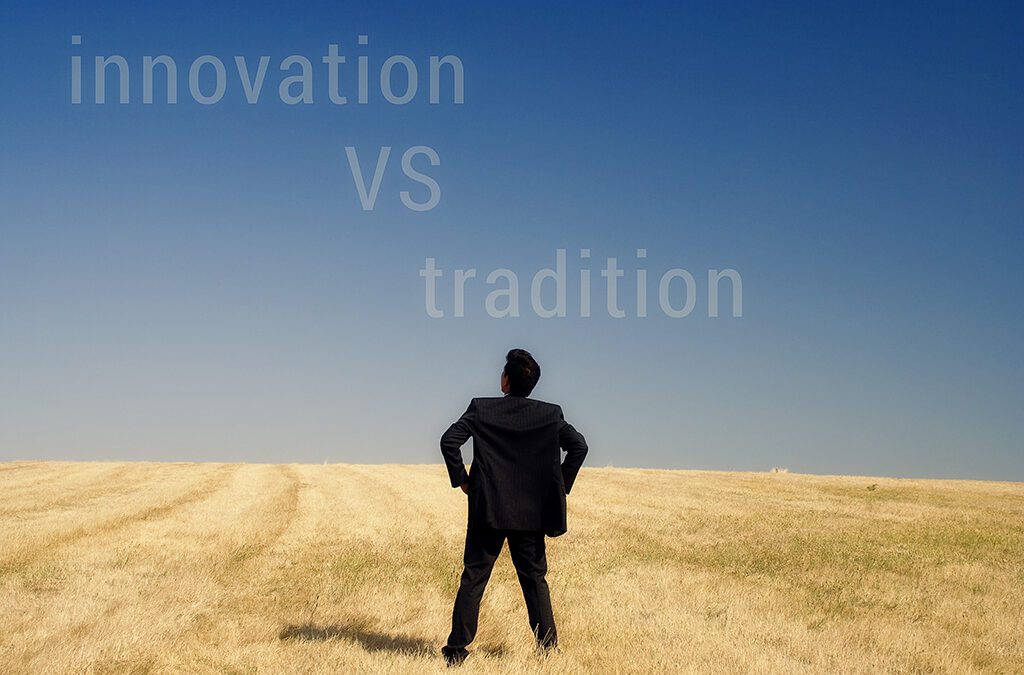
Nov 6, 2023 | ALL Business is STILL Show Business, Business Distinction, Customer Experience, Daily Distinction, Personal Distinction
In the ever-evolving landscape of business, the delicate dance between honoring tradition and embracing innovation is a critical one. Are you so bound in the past that you fail to focus on the future? Or are you so forward-looking, you ignore the values and traditions of your previous work?
This past weekend, Tammy and I attended the Past National Officer reception at the National FFA Convention. FFA (formerly the Future Farmers of America) played the primary role in my training for leadership and in speaking. It was an absolute blast to reconnect with so many great friends. However, what struck me was that the organization had the National FFA Officer team of fifty years ago present the opening ceremonies for the 30,000 students — mostly of high school age — in attendance.
You might think that these kids wouldn’t want to hear six 70-year-old men perform a 7-minute traditional ceremony — but that would not be the case. They cheered as if their favorite team had just scored in the final seconds of the big game. The FFA members were displaying they knew an important lesson we should all learn.
As we reflect on the legacies that have shaped industries, it is imperative to pay respect to past traditions; they are the bedrock upon which we build the future. However, revering tradition does not mean we should be ensnared by it. The art is in leveraging the foundational principles that defined our yesteryears while pivoting with agility to meet the dynamic needs of today’s customer experience.
Consider Apple, a company that respects the innovative spirit of its co-founder, Steve Wozniak (a fellow member of the In Residence faculty at High Point University), yet is not shackled by its past. Apple continues to push the boundaries of technology and design, all while maintaining a user-centric approach that has been the hallmark of its brand since its inception. This is a prime example of a company that transforms consumer expectations into customer experiences, all without losing sight of its core values.
Similarly, Netflix, under the guidance of co-founder Marc Randolph (another HPU colleague), revolutionized the home entertainment industry. It started with a traditional mail-order service and then boldly transitioned to streaming, leaving behind its old business model to adapt to new consumer behaviors. Netflix demonstrates the quintessential transition from respecting the past – note, not remaining in the past – to pioneering future possibilities, thereby crafting an ultimate customer experience.
My client BMW is another brand that honors its tradition of German engineering excellence, while also being a frontrunner in automotive innovation. The company’s commitment to producing the “ultimate driving machine” remains unwavering, yet it simultaneously forges ahead with electrification and autonomous driving technologies. This fusion of heritage with futuristic vision exemplifies the balance of honoring tradition without being trapped by it.
As we navigate the waters of change, we should reflect on our traditions, not as an anchor, but as a compass.
Our history is a source of invaluable insights and principles that can guide our innovation. Yet, to deliver the Ultimate Customer Experience ®, we must be willing to disrupt the status quo, to challenge the traditional ways of doing things if they no longer serve our contemporary customer.
Businesses that excel in innovation understand that tradition is not a destination; it’s a part of the journey. They honor the past by building upon it, not by staying within it. They recognize that to be remarkable in today’s market, to truly stand out, they must deliver an experience that is not merely different, but distinct. This requires an unyielding commitment to the present and future needs of customers, with an innovative mindset that is always looking ahead.
The Ultimate Customer Experience ® is a blend of reverence for the past and bold strides towards the future. As leaders and businesses, let us honor our traditions by allowing them to inform and inspire our innovative efforts.
In doing so, we not only pay homage to our origins but also pave the way for groundbreaking achievements that will, in turn, become the cherished traditions of tomorrow.

Mar 13, 2022 | ALL Business is STILL Show Business, Customer Experience, Leadership, Personal Distinction
Recording artists often release a “greatest hits” compilation. And let’s face it, when you go see your favorite singer or band, you certainly want to hear them play the songs you know by heart.
Yet, all my friends in the music business seem to have one thing in common. No matter how many hits they’ve previously recorded, they continue to create new material.
There’s a lesson there for every business and any leader.
Just as in show business, experimentation and change are essential to continued success no matter how successful you are. That’s why the most innovative companies encourage their employees to experiment and take risks. And it’s why the best leaders are always looking for ways to improve.
If you want your business or career to continue to flourish, don’t rest on your laurels. Many years ago, Rick Nelson revitalized his stagnant career with a song named “Garden Party.” In the tune, he talked about playing all the old hits but realized that “if memories were all I sang, I’d rather drive a truck.”
- Unfortunately, what we take for granted in the music industry isn’t always embraced in the corporate world. We seem to think we must keep “playing our hits” without developing new methods and approaches to dealing with customers.
I often inquire during my presentations, “Imagine I asked your customers to name something you’re doing differently or better to serve them today than how you did a couple of years ago. Would they be able to name an innovation or improved practice right away?” At this point, many in the crowd look down or shift their eyes away. You know the reason — most of us just keep doing what we’ve always done.
Here are three reasons we need to continue to innovate:
1) Experimentation allows us to find new and better ways to serve our customers. If we fail to try something unique — and our competition is willing to be creative — we run an enormous risk of turning our best clients into the competitor’s best prospects!
2) Change is essential to our survival. In the words of Charles Darwin, “It is not the strongest species that survives, nor the most intelligent, but rather the one that is most responsive to change.”
3) Innovation distinguishes us from our competition. If we’re not constantly striving to be better than those we compete against, we’ll soon find ourselves struggling to keep up.
If you’re not innovating, you’re falling behind. Don’t be afraid to experiment.
The next time you’re tempted to play it safe and just stick with what’s worked in the past, remember that your greatest hits may not be your greatest future.
- If you need to have your thinking challenged positively — or bounce ideas off of a leader to stimulate your creativity — I’d love to help. Whether through personal coaching, professional consulting, keynote presentations, or virtual training programs, we’re ready to help you expand your number of hits and earn standing ovations from your audiences (your team and your customers)! Just contact us for more information.

Feb 19, 2022 | ALL Business is STILL Show Business, Business Distinction, Customer Experience
When people think of success — whether business success or personal success — most usually think first of the logical factors involved. These include financial literacy, marketing skills, or management abilities.
When my first business book, ALL Business is Show Business, was released twenty years ago, my assertion that there was a significant element required for success that was almost always overlooked was met with considerable criticism.
The missing factor is EMOTION.
My point in my book was that just as a movie or television episode attempts to make you laugh, cry, become angry, or scared, emotion plays a crucial role in all fields of business, as well! Being able to understand how other people feel and being astute at influencing emotion are essential aspects of success in every field.
While intellect is critical when considering what makes a successful company or career, it’s still only half the picture. The rest of the picture involves understanding human emotion and communicating with other people — both customers and employees — on their emotional level, rather than just their intellectual level.
An old proverb says, “the hand that rules the mind also rules the world.”
Emotion often determines how people think, what they do or don’t do, and why they act in a certain way. Because emotion plays such a critical role in success, a mastery of the basic techniques of emotion management is crucial to business success. The real key to understanding emotion is recognizing its effect on the customer or employee decision-making process.
You’ll obviously become more successful if you can motivate other people to take action — whether it’s buying your product or becoming more productive as employees.
This past week, Dr. Sigal Barsade passed away at the young age of just 56. As the New York Times reported, “Dr. Barsade, a professor of management at the Wharton School, the business school of the University of Pennsylvania, was a pioneer in what organizational psychologists call the affective revolution: the study of how emotions, not just behavior and decision-making, shape a workplace culture, and in turn how they affect an organization’s performance.”
If emotion is effectively used, it greatly benefits the bottom line of any company.
As the Times article also reported,” ‘For a long time, emotions were viewed as noise, a nuisance, something to be ignored,’ Barsade told MIT Sloan Management Review in 2020. ‘But one thing we now know after more than a quarter-century of research is that emotions are not noise — rather, they are data. They reveal not just how people feel, but also what they think and how they will behave.'”
This is a crucial realization. Successful businesspeople look at emotion as a source of insight and realize that emotion can be influenced and leveraged positively, like every other resource in the workplace.
In summary:
- Being able to understand how other people feel and being astute at influencing emotion are both indispensable aspects of success in every field.
- You’ll obviously become more successful if you can motivate other people to take action — whether it’s buying your product or becoming more productive as employees.
- Emotion often determines how people think, what they do or don’t do, and why they act in a certain way.
- Using emotion effectively greatly benefits the bottom line of any company.
- Emotion is not noise — instead, it is data. It reveals how people feel, what they think, and how they behave.
Because — just as it was true twenty years ago — ALL business IS “show business.”

Feb 5, 2022 | ALL Business is STILL Show Business, Business Distinction, ICONIC, Leadership, Sales & Retail
Here’s a problematic question for entrepreneurs and managers: is it that people don’t want to work nowadays? Or is it that they don’t want to work for YOU?
Twenty years ago, I wrote that you must provide the “Ultimate Experience” for both customers and employees. Over the past two decades, we’ve observed significant strides in how organizations engage their customers. Frankly, we haven’t seen that level of progress across the board regarding employee engagement.
In the United States, we’ve heard many leaders talk about how today’s employees don’t want to work and are lazy. Many studies are confirming this is not true. The companies and managers who have had problems with employee engagement have failed to create an environment where their staff was happy or felt it was a place they wanted to work.
To have a successful business, you need happy and engaged employees. It’s not only the right thing to do, but it’s also good for business. Employees who are disengaged cost businesses billions of dollars every year in lost productivity. Gallup has even gone as far as saying that employee engagement is the key to success for any organization.
Here are a couple of questions for you:
- Have you designed the employee experience with as much passion and precision as you plan customer acquisition?
- Have you developed a specific list of WHY both current and prospective employees would recognize working for you as a superior option from their other opportunities?
For most, frankly, the answer will be, “No.”
That needs to change — and it needs to change now if you want to attract and retain a superior team.
So, what can you do to create an environment where your employees want to work? It’s not easy and takes time, but here are five tips:
- Treat your employees with respect. This includes listening to them and considering their ideas.
- As I wrote in “ICONIC,” respect is reciprocal. If you want your team to respect and value you and your organization, you must display how you value and respect them FIRST.
- Make certain they feel appreciated. The best way to make your employees feel part of the company is by giving them ongoing recognition. In other words, leaders don’t recognize their work only when milestones are met or when achieving sales targets.
- Recognition can be in many forms, including praise for doing a job well done, even if it’s not on the radar screen yet.
- Offer them development opportunities. No one wants to feel like they’re stuck in a dead-end job.
- Employees want to know that there is room for growth and that they are valued enough for the company to invest in their future.
- Let them have some fun! Work can be stressful, so it’s essential to find ways for employees to let off some steam.
- Whether through social activities, team-building exercises, or just taking a break for a little bit, employees need to know that they can have fun at work and not be all work and no play.
- Finally, PAY MORE! My great pal, Randy Pennington, related a story on a recent live stream where we both were guests about a consulting client of his that dramatically increased the compensation of his team. Guess what? It SAVED him money!
- How could this be the case?
- He reduced his expenses of recruiting and onboarding new team members.
- He drastically reduced turnover.
- He kept his best employees and attracted top-level recruits.
- He prevented massive overtime outlays because he now had a productive team that could get the work done during regular hours.
- AND the fact that no one had to put in extra time meant happier employees and families.
The next time you think about how employees “just don’t want to work today,” remember it’s not because they’re lazy. It’s likely because they aren’t attracted to work for a company that they aren’t certain appreciates them or doesn’t have their best interests at heart.
Change your ways and see how your employees change their tune!
If you can successfully implement these tips, you’ll be well on your way to having an engaged and happy team!

Apr 4, 2021 | ALL Business is STILL Show Business, Business Distinction, Customer Experience
To approach your business as “show business” is not to be confused with putting on an act, being overly dramatic, or being fake.
- It’s about differentiating yourself from the competition by understanding your clients in the same way that show business understands their audience.
- It’s about creating specific strategies based on your customer’s distinct preference in order to deliver experiences that are compelling and engaging.
- It’s about taking what we can learn from the entertainment business and leverage that insight into building strong and lasting emotional connections with our clients and colleagues.

Mar 21, 2021 | ALL Business is STILL Show Business, Business Distinction, Customer Experience
Your customer’s measuring stick for efficiency may be entirely different from yours, and if you’re not aligned with your customer’s expectations, then you’re never going to meet their needs. Customer service and customer
experience should not be confused.
Remembering that all business is show business…
You can be creative despite limited resources. “The power of ideas can often compensate for the lack of size.”
Consider the following:
- The 1978 slasher flick Halloween had a $325,000 budget but went on to make $47 million at the box office.
- 2004’s Saw’s budget was only $1.2 million, and yet it earned $103 million.
- Napoleon Dynamite’s budget was only $400,000, and it made an impressive $46 million.
- Who could forget the phenomenon that was The Blair Witch Project that had a $60,000 budget but ultimately earned $140.5 million?
It doesn’t matter how large or well-funded your business is, adopting the show business philosophy can impact your future success in a major way.
You can go a long way with superior creativity when it’s matched with strategic execution.






